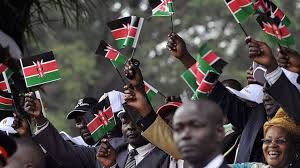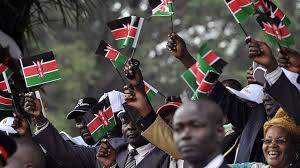INTRODUCTION
This post discusses the political history of Kenya, the early history, independence, multi-party parties and present day Kenya.
EARLY HISTORY:
A part of Eastern Africa, the territory of what is known as Kenya has seen human habitation since the beginning of the Lower Paleolithic. The Bantu expansion from a West African centre of dispersal reached the area by the 1st millennium AD. With the borders of the modern state at the crossroads of the Bantu, Nilo-Saharan and Afro-Asiatic ethno-linguistic areas of Africa, Kenya is a truly multi-ethnic state.
The European and Arab presence in Mombasa dates to the Early Modern period, but European exploration of the interior began in the 19th century. The British Empire established the East Africa Protectorate in 1895, from 1920 known as the Kenya Colony.
INDEPENDENCE OF KENYA
In 1962, a KANU-KADU coalition government, including both Kenyatta and Ngala, was formed. The 1962 constitution established a bicameral legislature consisting of a 117-member House of Representatives and a 41-member Senate. The country was divided into 7 semi-autonomous regions, each with its own regional assembly. The quota principle of reserved seats for non-Africans was abandoned, and open elections were held in May 1963. KADU gained control of the assemblies in the Rift Valley, Coast and Western regions. KANU won majorities in the Senate and House of Representatives, and in the assemblies in the Central, Eastern and Nyanza regions. Kenya now achieved internal self-government with Jomo Kenyatta as its first president. The British and KANU agreed, over KADU protests, to constitutional changes in October 1963 strengthening the central government, ensuring that Kenya would be a de facto single-party state. Kenya attained independence on 12 December 1963and was declared a republic on 12 December 1964 with Jomo Kenyatta as Head of State. In 1964 constitutional changes further centralized the government and various state organs were formed. One of the key state organs was the Central Bank of Kenya which was established in 1966.
Read: Political History Of Senatorial Zones In Nigeria
The British government bought out the white settlers and they mostly left Kenya. The Indian minority dominated retail business in the cities and most towns, but was deeply distrusted by the Africans. As a result, 120,000 of the 176,000 Indians kept their old British passports rather than become citizens of an independent Kenya; large numbers left Kenya, most of them headed to Britain.
INDEPENDENT REPUBLIC OF KENYA:
The independent Republic of Kenya was formed in 1963. It was ruled as a de facto one-party state by the Kenya African National Union (KANU), led by Jomo Kenyatta from 1963 to 1978. Kenyatta was succeeded by Daniel arap Moi, who ruled until 2002. Moi attempted to transform the de facto one-party status of Kenya into a de jure status during the 1980s, but with the end of the Cold War, the practices of political repression and torture which had been “overlooked” by the Western powers as necessary evils in the effort to contain communism were no longer tolerated.
Moi came under pressure, notably by US ambassador Smith Hempstone, to restore a multi-party system, which he did by 1991. Moi won elections in 1992 and 1997, which were overshadowed by politically motivated killings on both sides. During the 1990s, evidence of Moi’s involvement in human rights abuses and corruption, such as the Goldenberg scandal, was uncovered. He was constitutionally barred from running in the 2002 election, which was won by Mwai Kibaki. Widely reported electoral fraud on Kibaki’s side in the 2007 elections resulted in the 2007–2008 Kenyan crisis. Kibaki was succeeded by Uhuru Kenyatta in the 2013 general election. There were allegations that his rival Raila Odinga actually won the contest, however, the Supreme Court through a thorough review of evidence adduced found no malpractice during the conduct of the 2013 general election both from the IEBC and the Jubilee Party of Uhuru Kenyatta. Uhuru was re-elected in office five years later in 2017. His victory was however controversial. The Supreme Court had vitiated Uhuru win after Raila Odinga disputed the result through a constitutionally allowed Supreme Court petition. Raila Odinga would later boycott a repeat election ordered by the court, allowing Uhuru Kenyatta sail through almost unopposed with 98% of the vote.
Multi-party politics
After local and foreign pressure, in December 1991, parliament repealed the one-party section of the constitution. The first multiparty elections were held in 1992.
The Forum for the Restoration of Democracy (FORD) emerged as the leading opposition to KANU, and dozens of leading KANU figures switched parties. But FORD, led by Oginga Odinga(1911–1994), a Luo, and Kenneth Matiba, a Kikuyu, split into two ethnically based factions. In the first open presidential elections in a quarter century, in December 1992, Moi won with 37% of the vote, Matiba received 26%, Mwai Kibaki (of the mostly Kikuyu Democratic Party) 19%, and Odinga 18%. In the Assembly, KANU won 97 of the 188 seats at stake. Moi’s government in 1993 agreed to economic reforms long urged by the World Bank and the International Monetary Fund, which restored enough aid for Kenya to service its $7.5 billion foreign debt.

Obstructing the press both before and after the 1992 elections, Moi continually maintained that multiparty politics would only promote tribal conflict. His own regime depended upon exploitation of inter-group hatreds. Under Moi, the apparatus of clientage and control was underpinned by the system of powerful provincial commissioners, each with a bureaucratic hierarchy based on chiefs (and their police) that was more powerful than the elected members of parliament. Elected local councils lost most of their power, and the provincial bosses were answerable only to the central government, which in turn was dominated by the president. The emergence of mass opposition in 1990–91 and demands for constitutional reform were met by rallies against pluralism. The regime leaned on the support of the Kalenjin and incited the Maasai against the Kikuyu. Government politicians denounced the Kikuyu as traitors, obstructed their registration as voters and threatened them with dispossession. In 1993 and after, mass evictions of Kikuyu took place, often with the direct involvement of army, police and game rangers. Armed clashes and many casualties, including deaths, resulted.
Further liberalization in November 1997 allowed the expansion of political parties from 11 to 26. President Moi won re-election as president in the December 1997 elections, and his KANU Party narrowly retained its parliamentary majority.
Moi ruled using a strategic mixture of ethnic favoritism, state repression and marginalization of opposition forces. He utilized detention and torture, looted public finances and appropriated land and other property. Moi sponsored irregular army units that attacked the Luo, Luhya and Kikuyu communities, and he denied his responsibility by attributing the violence to ethnic clashes arising from land dispute. Beginning in 1998, Moi engaged in a carefully calculated strategy to manage the presidential succession in his and his party’s favor. Faced with the challenge of a new, multiethnic political coalition, Moi shifted the axis of the 2002 electoral contest from ethnicity to the politics of generational conflict. The strategy backfired, ripping his party wide open and resulting in the humiliating defeat of its candidate, Kenyatta’s son, in the December 2002 general elections.
Recent history (2002 to present)
Constitutionally barred from running in the December 2002 presidential elections, Moi unsuccessfully promoted Uhuru Kenyatta, the son of Kenya’s first President, as his successor. A rainbow coalition of opposition parties routed the ruling KANU party, and its leader, Moi’s former vice-president Mwai Kibaki, was elected president by a large majority.
On 27 December 2002, by 62% the voters overwhelmingly elected members of the National Rainbow Coalition (NaRC) to parliament and NaRC candidate Mwai Kibaki (b. 1931) to the presidency. Voters rejected the Kenya African National Union’s (KANU) presidential candidate, Uhuru Kenyatta, the handpicked candidate of outgoing president Moi. International and local observers reported the 2002 elections to be generally fairer and less violent than those of both 1992 and 1997. His strong showing allowed Kibaki to choose a cabinet, to seek international support and to balance power within the NaRC.


